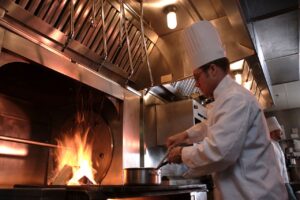
Fire safety considerations for new restaurant builds and renovations are critical for ensuring the safety of your property, employees and customers.
Opening a new restaurant or undertaking a major renovation is an exciting venture filled with opportunity. However, it’s also a time when you must make critical decisions that impact the safety and longevity of your establishment. Among the most important—and regulated—of these decisions are those involving fire protection. Fire safety considerations for new restaurant builds are not only essential for meeting local code requirements, but also for protecting your staff, customers, and investment.
The Importance of Fire Safety in Restaurants
Restaurants are uniquely susceptible to fire hazards. Open flames, hot cooking surfaces, grease buildup, and electrical equipment are all part of daily operations. Without proper fire safety systems and proactive planning, even a small mistake can turn into a catastrophic event. That’s why fire safety considerations for new restaurant builds and remodels must be built into the design and development process from day one.
Commercial Kitchen Hood and Ventilation Systems
Proper ventilation is one of the most important fire safety elements in any commercial kitchen. Grease-laden vapors from cooking appliances must be captured and filtered to reduce buildup, which can quickly ignite. Fire suppression systems integrated into kitchen hoods are also mandatory in most jurisdictions.
Tips:
- Install UL 300-compliant kitchen hood suppression systems.
- Ensure regular maintenance and cleaning schedules are in place for all hoods and ducts.
- Choose stainless steel ductwork for durability and easier grease removal.
Fire Suppression Systems
Automatic fire suppression systems are critical to minimize damage and injury in the event of a fire. In most cases, local codes will require a system tailored to restaurant-specific hazards.
Common types include:
- Wet chemical systems for kitchen appliances
- Sprinkler systems throughout the building
- Standalone extinguishers rated for Class K fires
Building Layout and Fire Exits
When designing the layout of a new restaurant or renovation, fire exits must be easily accessible and clearly marked. Seating arrangements, kitchen placement, and employee workspaces should not obstruct exit routes.
Design considerations:
- Minimum of two accessible exits
- Illuminated exit signs
- Emergency lighting in case of power failure
- Clearly defined evacuation routes
Fire-Rated Materials and Construction
Fire-rated doors, walls, and ceilings can slow the spread of flames and give occupants more time to evacuate. These materials are particularly important in kitchens, storage areas, and places with high fire loads.
Best practices:
- Use fire-rated gypsum board, steel doors, and fire-resistant insulation
- Install self-closing doors for areas with combustible materials
- Separate cooking areas from public dining zones when possible
Electrical and Gas Safety
Faulty wiring and gas leaks are two of the leading causes of fires in restaurants. All new restaurant builds and renovations should include a thorough inspection of electrical and gas lines.
Key safety measures:
- Use commercial-grade wiring and circuit breakers
- Include emergency shut-off valves for gas lines
- Install smoke detectors and gas leak detectors
Compliance with Local Fire Codes and Inspections
Every city and county has specific fire codes that restaurants must follow. During construction or renovation, schedule regular inspections to ensure your fire safety systems are up to code.
Fire code compliance checklist:
- Secure permits before construction begins
- Schedule fire marshal inspections
- Update systems as codes evolve
- Train staff on fire emergency procedures
Staff Training and Emergency Preparedness
A well-trained team can be your first line of defense during a fire emergency. Staff should be trained in fire extinguisher use, emergency shutdown procedures, and customer evacuation techniques.
Training tips:
- Conduct quarterly fire drills
- Post emergency procedures in visible areas
- Ensure every employee knows their role during an emergency
Final Thoughts
Fire safety considerations for new restaurant builds are more than just a legal requirement—they’re a foundational component of responsible business ownership. By prioritizing safety in the planning and design phases, restaurant owners can prevent disasters, reduce liability, and create a safer environment for everyone who walks through the door.
Fire Protection Services from Fireline
Whether you need smoke detectors, fire extinguishers, or an automatic sprinkler system installed at your commercial property, Fireline has you covered. We have been protecting people and property from fire damage since 1947—and our experience shows in our excellent work! We are known for our superb customer service, our expertise, and our reliability. For more information on how we can help your residential or commercial property, visit us online or give us a call at (800) 553-3405. We are in Baltimore, MD, with a second office in Leesburg, VA. For more fire safety tips, be sure to follow us on Facebook, Twitter, and LinkedIn.
